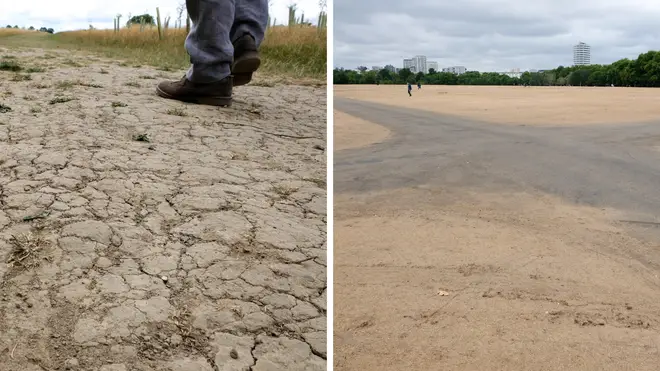
Ben Kentish 10pm - 1am
27 July 2022, 15:03

England has had its driest July since 1911 so far this month, figures from the Met Office show.
The latest data reveals there has only been 15.8mm (0.6in) of rain averaged across England so far - just 24 per cent of what would be expected for the whole month.
The Met Office said that at this stage in the month - up to July 26 - the country would have expected well over three-quarters of the month's rain to have already fallen in an average July.
Read more: Surrey wildfire enters fourth day with 120 acres of nature reserve already burnt
Read more: Drought 'very likely' as England sees driest start to year since '76
Across the UK it has been the driest July since 1984 so far, with an average of 37.7mm of rain.
It is the eighth driest month in records stretching back to 1836.
With five days to go, July 2022 is currently the second driest July for England since records began in 1836, behind 1911.

Footage shows Wennington fire devastation amid UK heatwave
There is still time for things to change slightly over the remaining days of the month, but the Met Office warns there is little significant rain forecast for southern and eastern England.
As a result there is not much prospect of a significant improvement in the next week or two.
Read more: England facing August drought with hosepipe bans as more 'very hot weather' expected
Read more: Met Office issues warning for thunderstorms and heavy showers after days of blistering heat
Figures also show England has had the driest eight-month period from November 2021 to June 2022 since 1976, when the country struggled with severe drought.
Over that period, just 421mm of rain has fallen across England - less than three quarters of the 1991-2020 average.

Welder tells LBC his colleagues will die at work in heatwave
Mark McCarthy, head of the Met Office National Climate Information Centre, said: "It is not just July that has been dry.
"Since the start of the year, all months apart from February have been drier than average in the UK too.
"The result of this is that the winter, spring and summer of 2022 have all seen less than the UK average seasonal rainfall.
"England has seen the lowest levels during these periods and rainfall totals for the first six months of the year are around 25 per cent below their long-term average, with the driest regions in the east and south-east."
Read more: Street like a 'warzone': Shocking clip shows aftermath of wildfire in London
Read more: 'Devastation' as huge fire rips through Norfolk as major incident declared
But the Met Office warned against comparing 2022 too closely to 1976 because, despite the dry trend, England has had 30 per cent more rain over the first six months of the year than it did 46 years ago.
The figures for July show that Scotland has had closer to the average rain in the north and west, but there have been drier conditions in the south and east of the country.
Overall, Scotland has had 71 per cent of the average rain for the month, Wales has had 39 per cent, and Northern Ireland has had 43 per cent.
The most extreme dry conditions are in East Anglia and south-east England.

Climate scientist hits out at cognitive dissonance of climate deniers
The figures come after officials met water company representatives and farmers to discuss how to cope with the dry conditions, amid warnings that England could be in drought in August if the warm, dry weather continues.
July has also experienced above-average temperatures for much of the month, including heatwave conditions around July 10-13 and from July 16, with exceptional heat during July 18-19 - when temperatures soared above 40C for the first time on record.
Early provisional statistics for July show the average maximum temperature for the month is 21.7C - 2C higher than the average for the month and one of the five warmest Julys on record.
Read more: Female hiker falls 100ft to her death while walking with her husband in the Dolomites
Watch: 'You're jealous': James O'Brien dissects caller's opposition to striking workers
Heatwaves are being made increasingly frequent, longer and more intense as a result of climate change, which is also set to bring other changes such as hotter, drier summers and warmer, wetter winters to the UK.
Mr McCarthy said: "Met Office climate change projections highlight an increasing trend towards hotter and drier summers for the UK, with the driest regions anticipated to be in the south and east.
"While trends in summer temperature and heatwaves are very apparent in the climate records of recent decades, the large variability in our rainfall means that it is too soon to be able to detect the pattern in summer rainfall."